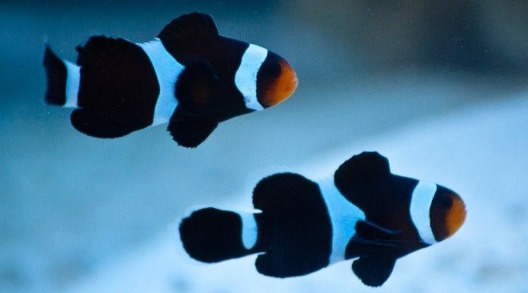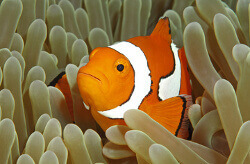Ocellaris Clownfish - Male or Female

A lot of people want to know whether their Ocellaris Clownfish is male or female for a number of different reasons. Some people are just curious and others have hopes of one day breeding their clownfish. After all, clownfish are among the easiest of marine fish to get to spawn in the home aquarium. So how can you tell if your clownfish is male or female? It is not always simple, but here are some things to look for that will give you a good idea of whether your clownfish is male or female.
Size Matters
Yes, in the clownfish world, size does matter. But, it's not what you think. For clownfish, the females are larger than the males. So if you have a large clownfish or a clownfish that has been alone for a long period of time, chances are that it is a female.
Female clownfish are much more dominant than their male counterparts. They greedily try to eat most of the food that gets into the tank (which is one reason the males don't grow as large). They will often aggressively protect their "home", whether that be an anenome, a nesting site, a clay pot or the entire fish tank. If it attacks your hand when you're trying to clean the glass or it won't let any other fish near its spot, you most likely have a female clownfish.
The following video shows a large female clownfish with a young male. This bonded pair is very settled into their roles, thanks to the vast size difference. The female is in charge and the male will eventually tend to the eggs and follow the female wherever she goes.
Can Ocellaris Clownfish Change Sex?
First, to be clear, all clownfish are born gender neutral. They are not male nor female at birth and as juveniles. The other thing that makes sexing Ocellaris Clownfish difficult is that they can become male and then female. This means that a juvenile clownfish can turn into a male, and the same clownfish can later change sexes to become a female. Once they become female they cannot change back to male.
This is how the social hierarchy works for clownfish: There is one dominant female clownfish, partnered with a male, who is the next most dominant fish. The female is larger (often much larger) than the male. Next are non-mating males and juveniles. They are usually smaller still than the dominant male. If the male mate were to die, the next dominant male would become the mate (if the female accepts him). If the female were to die, then the dominant male would change to female and the next male in line would become the mate.
Of course, that is in a perfect world, the open reef. In our tanks it is not always that simple. If you introduce two fish at the same time then one will likely become the female and the other male. This does not guarantee that they will mate. You will be able to tell which is the female because she will be much more aggressive. Often, the female will barely let the male eat and sometimes will almost control where in the tank the male is allowed to go. This will go on until the male submits or is killed by the female.
Male Clownfish Submission
When an Ocellaris Clownfish submits to the dominant female it is quite a site. The fish will actually turn on its side and shake, almost like a spasm. The female will then usually relent, but will often check back to make sure the male stays in line, so to speak. Once the male submits, they can become a pair, but they do not always become a pair.
Below is a great video which shows this unusual behavior. You will notice these two fish are similar in size, but they seem to have already figured out their roles. One fish swims normally through the video while the other tends to turn to his side and shake, showing submission to the female.
Bonded clownfish consist of a male and a female and usually will spend all of their time together. They will swim together, host together (if they host), and even sleep together. Just because the pair are bonded does not always mean they will mate. A mated pair of clownfish are just that - a bonded pair that have mated. If they have not mated then they should not be called a mated pair. Beware of places selling "pairs" and "mated pairs" of clownfish. While they often are selling true mated pairs, be sure you know whether the fish have actually spawned or not before finalizing the purchase. A good clownfish breeder should be able to easily prove this with a picture or video.
Overview
So in the most general sense, if you have a very young clownfish, it is likely neither male nor female. If you have one clownfish that is a bit older or has been by itself for some time then it is likely a female. If you have more than one, then the female will be larger and more aggressive. The next most aggressive will probably be male and the rest will most likely either be males or juveniles.


